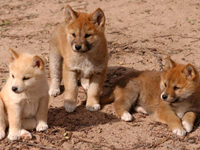

 |

|
 Dingo |
Dingo(Mammal) |
 Dingo Baby |
Dingo HabitsDingoes live in family groups within a primary territory. Their home range, however, is much larger, often overlapping other groups. Young male dingoes forage alone over a wide area, often covering as much as 40 miles in a night. They may join local family groups when food is abundant; when it is scarce, they will be driven away.
Australia's largest mammalian predator, Dingoes have been present in Australia for at least 3 500 years and perhaps as long as 11 000 years. They have an important ecological role, helping suppress populations of feral animals, and there is anecdotal evidence they help maintain populations of endangered species by excluding introduced feral predators like cats and foxes. Fatal attacks on humans are extremely rare, but since the co-existence with humans is present, fatalities can be possible. It is believed that Dingoes originally were a domestic dog brought to Australia by the aborigines. Because they often breed with domestic dogs, it is believed that only about 25% of Dingoes alive today are purebreds. |
Dingo CommunicationLike all domestic dogs, dingoes tend towards a phonetic communication, the difference being that they mostly use howling and whimpering rather than barking. Compared to most other dogs, the bark of a dingo is short. Barking is almost exclusively used for giving warnings. Usually there are three kinds of howls distinguished: long and persistent, rising and ebbing, and short and abrupt. |
Dingo BreedingIn fall or early winter, the female dingo comes into heat. She selects a mate, often the father of her previous litter of pups, from the pack of males that follow her. The pack then breaks up, leaving the pair alone to breed.
Pups are born nine weeks later. The female gives birth in the same hidden, sheltered location each year unless it is disturbed by humans or predators. Although the pups are weaned after eight weeks, they remain with their parents for up to a year. The female suckles her pups and also feeds them with small pieces of regurgitated meat. The pups grow quickly, and both parents must hunt food for them. They travel long distances in search of prey, but prey close to their own territory is left untouched, so that the pups may learn to hunt it themselves. |
Dingo Food & FeedingSince most of their prey is nocturnal, dingoes hunt at night. They hunt alone or in packs. When a pack kills more than it can eat, the remains are buried and dug up later. When dingoes hunt a large animal, such as the gray kangaroo, they give chase and charge their prey. After biting it, they come back off to avoid being kicked, as this can be fatal. As sheep farming has become widespread across Australia, dingoes have found the flocks to be easy prey. The dingoes usually kill only as much as they can eat, although pups can become overly excited, killing injuring many sheep. When food is scarce, dingoes will eat bird eggs, grubs, and wildfowl. |
Dingo Key Facts |
| Size |
| Height: Length: 44-73 in. Tail 18-30in. |
| Weight: Males, 125-250 lb. Females, 100-200 lb |
| Breeding |
| Sexual maturity: 2 years |
| Mating: June to August |
| Gestation: 63 days |
| Number of young: Up to 8 pups |
| Lifestyle |
| Habit: Males territorial. Family groups may include young of previous litter |
| Diet: Rabbits, small marsupials, kangaroos, and farm animals |
| Lifespan: 14 years |
DID YOU KNOW?
|
CAN'T FIND WHAT YOU'RE LOOKING FOR? CLICK HERE!!!